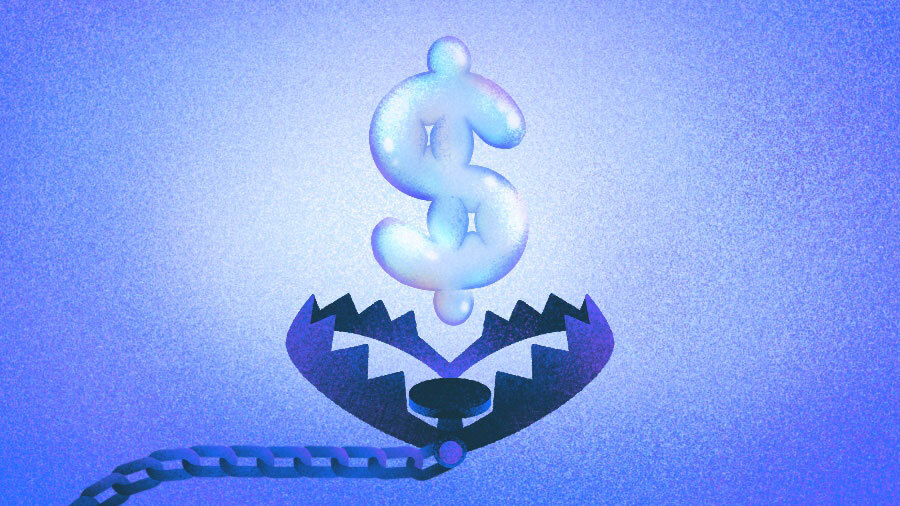The Great ‘AI Bubble’ Debate
A question that appears to be polarizing the tech community, once again: Are we in a bubble?
Bubbles emerge when a market becomes irrationally optimistic, causing the price of assets to diverge from their fundamental value. The critical moment is the formation of a recursive loop where price growth creates FOMO that pulls in more capital that further accelerates price growth. The end result is an increasingly unstable house of cards.
AI investment differs in two major ways from this historical pattern:
First, unlike previous bubbles (e.g. dotcom) there is significant revenue being generated by the underlying companies — implying real fundamental value. While questions have been raised about how much of this revenue is just recirculated capital, the growth is undeniable.
Second, these are private companies that aren’t easily accessed by investors, and the biggest names are selective about who gets on their cap table. Typically, bubbles play out in more liquid public markets, where sentiment can drive extreme swings in buy and sell activity.
Price vs. value
The final question: To what extent has price diverged from value?
For clarity, valuation is an opinion on the future, whereas pricing reflects the current fundraising market, so this is a mostly subjective issue. One investor might believe foundation models are the future of how we engage with technology, while another might just see them as an evolution of SaaS. Both are valid, and the speculative nature of VC means there should always be a range of perspectives.
However, venture capital is also influenced by herd behavior, with inflows being influenced by simple narratives about opportunity. Research shows that where investors concentrate on a particular sector, it tends to push up prices without implying better outcomes in future. That appears to align with venture capital activity in AI, as investors complain more frequently about the terms they’re faced with on competitive deals.
So, there is definitely some discomfort in the market. There is significant enthusiasm for AI, genuine optimism about the future, but also concern for how deals are playing out. Investors are gambling huge amounts of capital on the future of AI, too afraid to make an error of omission.
A risk bubble
The best way to consider might be in similar terms to Bill Gurley’s take on the venture market in 2015, which is that it’s a risk bubble, rather than a valuation bubble:
“All of this suggests that we are not in a valuation bubble, as the mainstream media seems to think. We are in a risk bubble. Companies are taking on huge burn rates to justify spending the capital they are raising in these enormous financings, putting their long-term viability in jeopardy. Late-stage investors, desperately afraid of missing out on acquiring shareholding positions in possible ‘unicorn’ companies, have essentially abandoned their traditional risk analysis. Traditional early-stage investors, institutional public investors, and anyone with extra millions are rushing in to the high-stakes, late-stage game.”
In conclusion, it doesn’t appear correct to characterise AI as a bubble in the traditional sense. Instead, venture capitalists have chosen huge systematic risk (undiversifiable reliance on AI), rather than the usual idiosyncratic risk (diversifiable across sectors) — which jeopardizes performance if the future doesn’t match up with today’s optimistic enthusiasm.
The bear case is probably not a total bust like 2000, but a mini-correction more similar to 2022. While portfolios won’t be wiped out, capital will end up locked away in overcapitalized private-market giants for longer than is comfortable for anyone involved, again.
Dan Gray, a frequent guest author for Crunchbase News, is the head of insights at Equidam, a platform for startup valuation.
Related reading:
- Startups Are Art, Valuation Is Science, Price Is Both
- Are YC Valuations Really Too High?
- Venture Capital’s Second(ary) Chance
- How Do You Value Pre-Revenue Startups?
- Should VCs Invest In ‘Jockeys’ Or ‘Horses’?
Illustration: Dom Guzman

The Great ‘AI Bubble’ Debate
A question that appears to be polarizing the tech community, once again: Are we in a bubble?
Bubbles emerge when a market becomes irrationally optimistic, causing the price of assets to diverge from their fundamental value. The critical moment is the formation of a recursive loop where price growth creates FOMO that pulls in more capital that further accelerates price growth. The end result is an increasingly unstable house of cards.
AI investment differs in two major ways from this historical pattern:
First, unlike previous bubbles (e.g. dotcom) there is significant revenue being generated by the underlying companies — implying real fundamental value. While questions have been raised about how much of this revenue is just recirculated capital, the growth is undeniable.
Second, these are private companies that aren’t easily accessed by investors, and the biggest names are selective about who gets on their cap table. Typically, bubbles play out in more liquid public markets, where sentiment can drive extreme swings in buy and sell activity.
Price vs. value
The final question: To what extent has price diverged from value?
For clarity, valuation is an opinion on the future, whereas pricing reflects the current fundraising market, so this is a mostly subjective issue. One investor might believe foundation models are the future of how we engage with technology, while another might just see them as an evolution of SaaS. Both are valid, and the speculative nature of VC means there should always be a range of perspectives.
However, venture capital is also influenced by herd behavior, with inflows being influenced by simple narratives about opportunity. Research shows that where investors concentrate on a particular sector, it tends to push up prices without implying better outcomes in future. That appears to align with venture capital activity in AI, as investors complain more frequently about the terms they’re faced with on competitive deals.
So, there is definitely some discomfort in the market. There is significant enthusiasm for AI, genuine optimism about the future, but also concern for how deals are playing out. Investors are gambling huge amounts of capital on the future of AI, too afraid to make an error of omission.
A risk bubble
The best way to consider might be in similar terms to Bill Gurley’s take on the venture market in 2015, which is that it’s a risk bubble, rather than a valuation bubble:
“All of this suggests that we are not in a valuation bubble, as the mainstream media seems to think. We are in a risk bubble. Companies are taking on huge burn rates to justify spending the capital they are raising in these enormous financings, putting their long-term viability in jeopardy. Late-stage investors, desperately afraid of missing out on acquiring shareholding positions in possible ‘unicorn’ companies, have essentially abandoned their traditional risk analysis. Traditional early-stage investors, institutional public investors, and anyone with extra millions are rushing in to the high-stakes, late-stage game.”
In conclusion, it doesn’t appear correct to characterise AI as a bubble in the traditional sense. Instead, venture capitalists have chosen huge systematic risk (undiversifiable reliance on AI), rather than the usual idiosyncratic risk (diversifiable across sectors) — which jeopardizes performance if the future doesn’t match up with today’s optimistic enthusiasm.
The bear case is probably not a total bust like 2000, but a mini-correction more similar to 2022. While portfolios won’t be wiped out, capital will end up locked away in overcapitalized private-market giants for longer than is comfortable for anyone involved, again.
Dan Gray, a frequent guest author for Crunchbase News, is the head of insights at Equidam, a platform for startup valuation.
Related reading:
- Startups Are Art, Valuation Is Science, Price Is Both
- Are YC Valuations Really Too High?
- Venture Capital’s Second(ary) Chance
- How Do You Value Pre-Revenue Startups?
- Should VCs Invest In ‘Jockeys’ Or ‘Horses’?
Illustration: Dom Guzman


